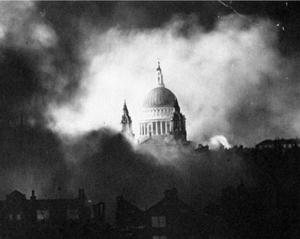
St Paul’s during London Blitz, December 29, 1940
Miraculously, John Donne’s effigy survived not only the burning of the medieval St Paul’s in 1666, but also the bombing of Sir Christopher Wren’s cathedral during the London Blitz. My uncle, Ned Young, writes:
“Reading in your synopsis about the great fire in London, and in particular about St Paul’s, reminded me of my first visit to that great edifice. It was during the war, but subsequent to the fire storm that raged in the area during the bombing raids. As I walked down Fleet Street it was amazing to see the church standing there, seemingly untouched, while all the buildings around it were burned to shells–just their brick walls remaining. Actually the church was not untouched, however. Last year I saw a dramatization of those raids, based on survivors’ recollections. Many incendiaries were dropped on the great dome, lighting a number of small fires, as it was made of wood. The wardens who were stationed inside up there had to put them out with buckets of water carried up from the main floor, as there was not enough pressure in the hoses to reach the top. If they had not been successful the entire dome would have collapsed. I wonder if John Donne’s effigy would have survived.”
The film Ned saw is The Blitz: London’s Longest Night, a documentary about December 29, 1940, the night when 136 German planes dropped incendiary bombs on the heart of London. A square mile of the City was burned, including a giant book warehouse on Shoe Lane. Miraculously, St Paul’s survived. Film clips from that night show the dome of St Paul’s rising triumphantly–a symbol of national pride and hope–out of the smoke and flames. More survivors’ stories appear in the WW II People’s War archive at the BBC.
